When editing the dialogue for the documentary I asked industry professionals that were available to have a listen to the work in progress so that I have a clear idea of what I need to change and what I’m doing right. I was very lucky that at the time Location Sound Recordist Grant Bridgeman was at the University of Lincoln giving guest lectures and workshops to the level 2 Audio Production Students and I met him in the Sound Theater during his preparation for a workshop. He Listened to my edits and audio and gave me specific tips on how to improve some of the clips –
As most of the location recordings were made in a live environment the main issue was that there was a constant crowd noise and low end rumble – Grant Suggested that I make a harsh 100Hz Cut with a noise reduction plug-in or EQ which would sort it out. He also told me to be careful with the lower frequencies of the music tracks as the room had a bass trap and could be quite tricky.
Most of the dialogue in general had that low/low-mid rumble due to the crowd noises so I made harsh cuts at 100Hz like Grant Suggested and slight dips in the lower and higher mids which sorted out the problem.
The audio clips have been checker-boarded for easier edits and for the achievement of better fades/transitions.
All of the dialogue tracks run separately and are rooted to individual SUB faders for each sequence which send the sygnal to a Dialogue Master Fader – I did the same for the musical tracks. The musical level automations throughout the documentary I did using the touch/latch option in pro-tools which involves manual fader operation. This gives me more control over the levels and a more natural feel for the flow of the music – this way I can quickly react to what is happening on screen and adjust the levels to my preference instantly. This technique was shown to me by Chris Hainstock when I asked him to give me feedback on my work in progress.
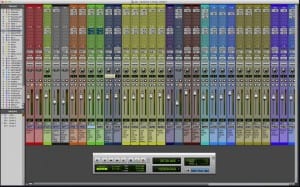
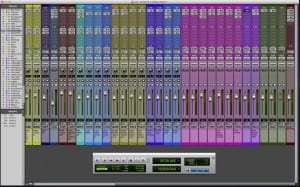
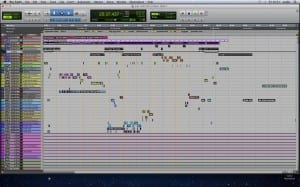
These are techniques that were taught to all Audio Production Students throughout levels 1 to 3 of our course by professionals such as Grant Bridgeman, Chris Hainstock , David McSherry etc. I have also used these techniques in previous projects and have achieved good results with great feedback.
Phil Stephens – Documentary and Film Producer, Chris Hainstock – Sound Editor with extensive experience within the industry also had a listen to the audio at a different stage of the post-production. They noticed some issues with the sync. of the audio and also some inconsistencies with the dialogue levels in a couple of scenes. After a few quick edits and changes they listened to it again and approved.
Having others (especially industry professionals) listening to my work while it’s till in progress helps me determine whether I’m going in the right direction and how I can improve the quality of the production – LO4 + LO6
23.11.15 Katia Isakoff – Guest Lecture
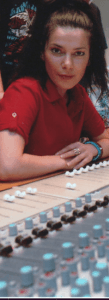
On the 23rd of November 2015 Music Producer and Mix Engineer Katia Isakoff spoke about the Women Produce Music Initiative. For the better part of the lecture we were given information on award nominated female sound engineers and producers and also details about the initiative itself. To sum up the entire session I can say that it was a very interesting and informative lecture but it did not have a great impact on the production process for my Audio Project 1. It was good to learn about the creation of new initiatives, the way they are promoted and how they grow. This information could be useful with future projects, their promotions and development.
30.11.15 – Ken Blair – Guest Lecture
Ken Blair – Acoustic, classical, jazz sound recordist, Owner BMP Recording gave a guest lecture on the 30th of November 2015.
He spoke about how a normal day at BMP Recording goes and the issues they encounter on location. He also touched upon how to conduct ourselves professionally when recording with multiple artists.
Ken specializes in the recording of classical orchestras in live environments. He has extensive experience within the UK and Overseas. From his lecture I understood that it is very important to be on location as early as possible so that a full assessment of the environment can be made. This in turn will assist with the unloading and setting up of the equipment leaving sufficient time for corrections and re-structuring if needed before the artists arrive. This includes the set up of a control room and that of the microphones that are going to be used (even if you are uncertain where the musicians are going to be) – this saves time when the artists arrive as it is very difficult to set up equipment when a lot of people are moving around the recording area. This sort of time management can be useful when recording on location – getting there early and assessing the environment making sure I have everything I need before we start filming/recording – LO1 + LO5.
Another important thing that Ken Blair talked about is how we treat the artists and how to conduct ourselves professionally during long recording sessions. Greeting the musicians accordingly is very important, we have to treat them as we would like to be treated. Offering them a hot or cold beverage is also a good way to break the ice and to make them feel more at ease/”at home”. This relaxes the artists and in turn impacts their performance in a positive way. This is a “technique” that I applied when recording the voice-overs in the studio and on location with all the interviewees. Talking to them and letting them know what is happening at all times, also including general talk to establish a friendly repore so that they feel more at ease during the interviews, offering them beverages if needed. – LO1.
MUSIC LICENCES
All of the music tracks that I used for the documentary have a Creative Commons Licence and are free to use:
“Hall of the Mountain King” Kevin MacLeod (incompetech.com)
Licensed under Creative Commons: By Attribution 3.0
http://creativecommons.org/licenses/by/3.0/
“Kawai Kitsune” Kevin MacLeod (incompetech.com)
Licensed under Creative Commons: By Attribution 3.0
http://creativecommons.org/licenses/by/3.0/
“The Path of the Goblin King v2” Kevin MacLeod (incompetech.com)
Licensed under Creative Commons: By Attribution 3.0
http://creativecommons.org/licenses/by/3.0/
“The Escalation” Kevin MacLeod (incompetech.com)
Licensed under Creative Commons: By Attribution 3.0
http://creativecommons.org/licenses/by/3.0/
“Dances and Dames” Kevin MacLeod (incompetech.com)
Licensed under Creative Commons: By Attribution 3.0
http://creativecommons.org/licenses/by/3.0/
“Unwritten Return” Kevin MacLeod (incompetech.com)
Licensed under Creative Commons: By Attribution 3.0
http://creativecommons.org/licenses/by/3.0/
“On Tiptoe” Chris Martin/Geoff Harvey (purple-planet.com)
Licensed under Creative Commons: By Attribution 3.0
http://creativecommons.org/licenses/by/3.0/
“Pippin the Hunchback” Kevin MacLeod (incompetech.com)
Licensed under Creative Commons: By Attribution 3.0
http://creativecommons.org/licenses/by/3.0/

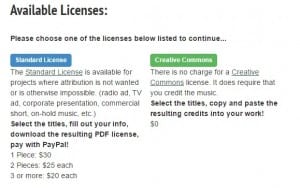
BIBLIOGRAPHY
Millerson, G. (2001) Video Production Handbook. Oxford: Focal Press.
Crook, T. (2012) The Sound Handbook. London: Routledge.
Milton, M. (2014) Sound Devices 633 – First Look Review. [online] Mary Milton – freelance sound recordist. Available from: http://marymilton.co.uk/sound-devices-633-first-look/ [Accessed October 21st 2015].
Sound & Picture (2014) Sound Devices Goes on Expedition with veteran Sound Mixer David Ruddick. [online] Sound&Picture. Available from http://soundandpicture.com/2014/07/sound-devices-goes-on-expedition-with-veteran-sound-mixer-david-ruddick/ [Accessed October 21st 2015].
Trew Audio (2013) Interview With Ed Capp – Sound Devices 633. [online video] Available from https://www.youtube.com/watch?v=zMLpXvRuk8A [Accessed October 19th 2015].
Harding, J. G. (2011, April). Sound & Sync – An Introduction to Location Sound. Retrieved from Sound on Sound : http://www.soundonsound.com/sos/apr11/articles/simple-sound-sync.htm
Bailey, S. (2015). Shooting on location: Sam Bailey. Retrieved from BBC Academy: http://www.bbc.co.uk/academy/journalism/article/art20130702112133392